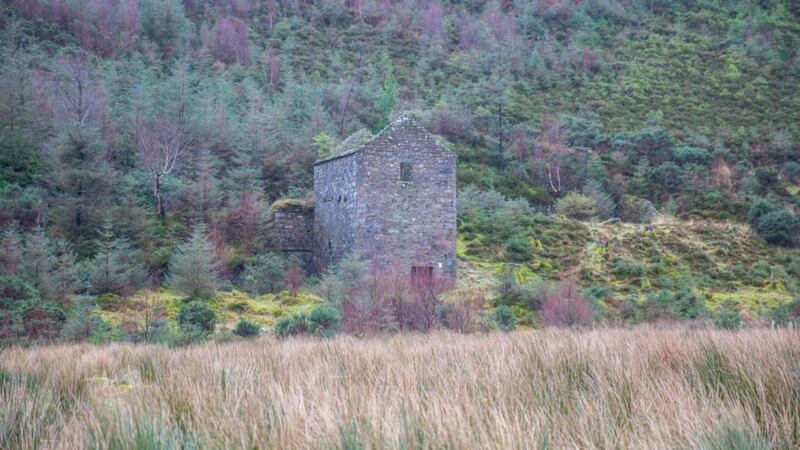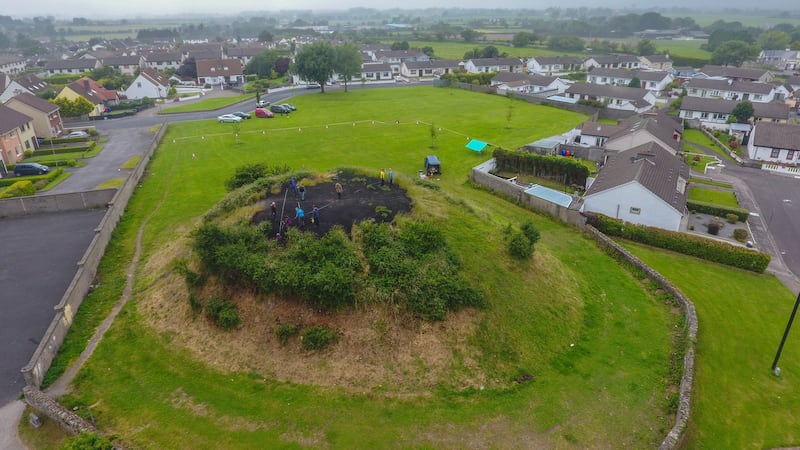Charles O’Byrne, who is a hillwalking guide in Co Wicklow, passes me a fraughan from a bush close to the ruins of the 19th-century Baravore crusher house, in Glenmalure Valley. The sweet bilberry reminds Pat Dunne, a local farmer, that above us is Fraughan Rock Glen, a popular hillwalking route to Lugnaquillia, the highest peak in the Wicklow Mountains.
The granite stone building, where lead was crushed in the mid-1800s, is what we’re here to see. It’s one of five historic buildings that have been taken on by their local communities under the Heritage Council’s Adopt a Monument contest.
The group today also includes Carmel O’Toole, a local historian and schoolteacher. Together they would like to develop a 4km looped walk to bring hikers past the crusher house and the adits – the horizontal entrances to the underground lead mines are scattered along the hillside, looping back past one of Ireland’s oldest An Óige hostels, at the top of the valley.


“People think there was never any habitation up here,” Dunne says, “but there were miners’ cottages, a shop, a pub and even a brothel when the mines were in full swing.”
This remnant of our industrial heritage reappeared only when the Coillte-owned coniferous forest was clear-felled, about eight years ago. The ruins of a smaller crusher house lie farther along the mountainside. Plans are afoot to put up an interpretative panel on the forest track, to inform walkers about the area’s mining past.
“The crusher house is a protected building, and the story about mining in the area might help make it safe,” O’Toole says.
The Adopt a Monument contest is keen to help community-based schemes such as the Baravore project, according to Ian Doyle of the Heritage Council. The competition, which follows a similar scheme in Scotland, attracted 90 applications this year.
“People across Ireland are facing insurmountable economic challenges when trying to regenerate their areas,” Doyle says. “This scheme allows them to start off with a manageable heritage project that needs conservation and that will encourage visitors to these places.”
The council’s partner in Adopt a Monument is Abarta Heritage, an Irish company that has developed interpretative apps for heritage sites; here its role is to support the winners of the scheme.
“They have allowed us to work with national bodies, and Coillte, the Mining Trust, An Óige and Wicklow County Council have all embraced our enthusiasm,” says Dunne.
Doon Fort, a drystone stronghold on Doon Lough, near Ardara in Co Donegal, is another winner of the contest. “It’s a secret gem of the Wild Atlantic Way, so we need to safeguard its future,” says Paula Harvey of Ardara GAP Heritage and History Group.
“It is the only early medieval fort on an island in a lake in Ireland,” says Róisín Burke of Abarta Heritage. Visits to the fort involve borrowing a farmer’s rowing boat when the weather allows. “It’s a fragile site,” she adds, “and we will have to look at alternative ways of seeing it, maybe by creating a viewing platform on a boardwalk around the lake.”
The people of Dungarvan and Lismore, in Co Waterford, are keen to see how Adopt a Monument will help their medieval forts.
The fort at Gallowshill, which was built by the Anglo-Normans, is surrounded by breeze-block walls in a housing estate undergoing restoration in Dungarvan. The site is used as a dumping ground and has a reputation for antisocial behaviour.
“We held a meeting about it,” Burke says, “and local people asked us what we are going to do about it. But I said, ‘It’s up to you: what do you want to be done with it?’ ”
The task at Round Hill, on the banks of the River Blackwater, is to develop a walk from the village of Lismore that takes in its motte and bailey.
A rare example of a Jacobean church in Killeshandra is another monument that has been adopted, this time by the Tidy Towns committee in the Co Cavan village. A plan is already in place to do urgently needed repairs on the barrel-vaulted ceilings; the group hopes the scheme will bring attention to the church and hurry work along.
“The church – Cill na Seanratha, or Church of the Rath – gave its name to the town, and we want local people to know its history,”says Eamonn Sexton of the Rath Church project team.
Perhaps the most surprising winner of the Adopt a Monument scheme is Ballintleva handball alley, near Dysart, in Co Roscommon. Built in the late 1930s, when handball was popular across Ireland, the alley was a focal point for the community; it even hosted part of the European one-wall handball championships in 1997. But it was deemed unsafe in the early 2000s.
The local community group hopes to reintroduce the sport to the primary school next door: pupils will be encouraged to unearth local stories as part of a folklore project. “We want the children to go and ask their grandparents about the sports they played and use the handball alley to talk about the traditions of a rural community,” Burke says.









